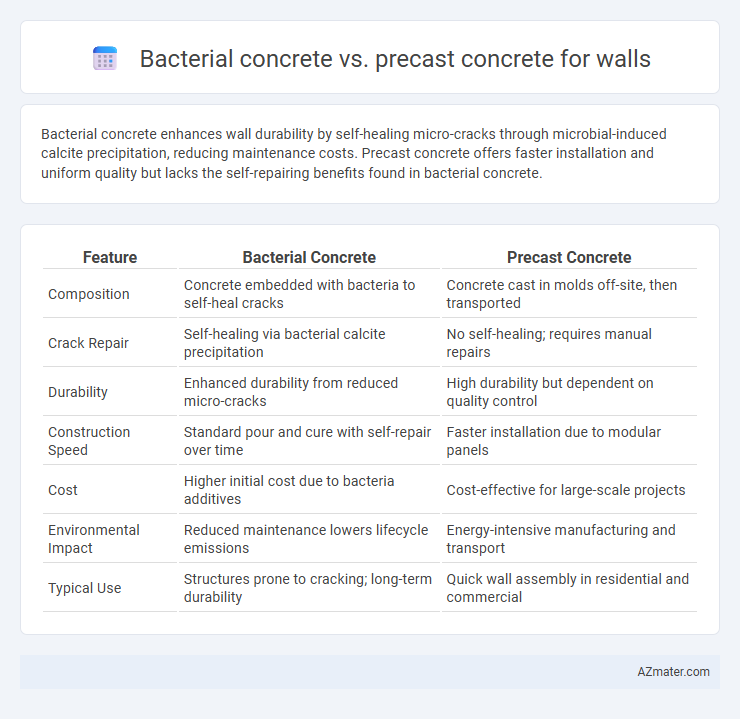Bacterial concrete enhances wall durability by self-healing micro-cracks through microbial-induced calcite precipitation, reducing maintenance costs. Precast concrete offers faster installation and uniform quality but lacks the self-repairing benefits found in bacterial concrete.
Table of Comparison
| Feature | Bacterial Concrete | Precast Concrete |
|---|---|---|
| Composition | Concrete embedded with bacteria to self-heal cracks | Concrete cast in molds off-site, then transported |
| Crack Repair | Self-healing via bacterial calcite precipitation | No self-healing; requires manual repairs |
| Durability | Enhanced durability from reduced micro-cracks | High durability but dependent on quality control |
| Construction Speed | Standard pour and cure with self-repair over time | Faster installation due to modular panels |
| Cost | Higher initial cost due to bacteria additives | Cost-effective for large-scale projects |
| Environmental Impact | Reduced maintenance lowers lifecycle emissions | Energy-intensive manufacturing and transport |
| Typical Use | Structures prone to cracking; long-term durability | Quick wall assembly in residential and commercial |
Introduction to Bacterial Concrete and Precast Concrete
Bacterial concrete incorporates microorganisms that induce calcium carbonate precipitation, enhancing crack resistance and self-healing properties in walls. Precast concrete involves manufacturing concrete components off-site under controlled conditions, ensuring consistent quality and rapid installation for wall construction. Both materials offer innovative solutions, with bacterial concrete improving durability through biological processes and precast concrete providing efficiency and structural precision.
Composition and Manufacturing Processes
Bacterial concrete incorporates specific bacteria and nutrients within traditional concrete mix, enabling self-healing through calcite precipitation, whereas precast concrete consists of cast concrete elements produced in controlled factory environments. Bacterial concrete's composition requires bio-additives carefully integrated during mixing, while precast concrete relies on standard cement, aggregates, and admixtures tailored for early strength gain and durability. Manufacturing bacterial concrete involves bio-engineering and curing conditions optimizing bacterial activity, contrasting with precast concrete's streamlined casting, curing, and quality control processes designed for uniformity and scalability.
Mechanisms of Strength and Durability
Bacterial concrete enhances strength and durability through microbial-induced calcite precipitation, which seals microcracks and pores, reducing permeability and increasing resistance to environmental degradation. Precast concrete achieves strength via controlled curing conditions and high-quality mix designs, offering uniform density and minimal defects. Bacterial concrete's self-healing capability extends structural lifespan by autonomously repairing damages, whereas precast concrete relies on manufacturing precision and post-installation maintenance for durability.
Crack Healing Capabilities
Bacterial concrete utilizes specific microorganisms to autonomously precipitate calcite, effectively sealing micro-cracks and enhancing durability by preventing water ingress. Precast concrete offers controlled manufacturing conditions ensuring uniform crack resistance but lacks intrinsic self-healing properties. The crack healing capabilities of bacterial concrete surpass those of precast concrete, making it more suitable for applications requiring long-term structural integrity and reduced maintenance.
Environmental Impact and Sustainability
Bacterial concrete incorporates microbes that precipitate calcium carbonate, enhancing durability and self-healing properties, which significantly reduce maintenance and extend the lifespan of structures, leading to lower environmental impact over time. Precast concrete offers controlled manufacturing conditions that optimize material use and reduce waste, but often relies on energy-intensive cement production contributing to higher carbon emissions. Choosing bacterial concrete for walls can increase sustainability through decreased resource consumption and carbon footprint compared to traditional precast methods.
Installation and Construction Efficiency
Bacterial concrete enhances self-healing properties, reducing maintenance and repair times during installation, which accelerates overall construction efficiency compared to precast concrete. Precast concrete walls benefit from factory-controlled production and rapid on-site assembly, minimizing weather-related delays and labor costs. While bacterial concrete offers innovative durability, precast concrete remains superior in speed and predictability of installation for wall construction projects.
Cost Comparison and Economic Viability
Bacterial concrete offers self-healing properties that reduce long-term maintenance costs, potentially lowering lifecycle expenses compared to traditional precast concrete walls. Initial installation costs for bacterial concrete are typically higher due to specialized materials and technology, but economic viability improves with durability and decreased repair frequency. Precast concrete remains cost-effective for large-scale projects due to mass production, while bacterial concrete is preferable in applications prioritizing sustainability and extended structural lifespan.
Maintenance Requirements and Longevity
Bacterial concrete incorporates self-healing bacteria that significantly reduce maintenance by autonomously sealing cracks, enhancing durability and extending the wall's lifespan beyond 50 years. Precast concrete walls, while offering consistent quality and faster installation, require regular inspections and routine repairs to address surface cracks and environmental wear, typically exhibiting a service life of 30 to 40 years. The self-healing properties of bacterial concrete minimize long-term maintenance costs, making it a superior choice for structures demanding high longevity and sustainability.
Applications in Modern Wall Construction
Bacterial concrete enhances wall durability by self-healing micro-cracks, making it ideal for infrastructures exposed to harsh environmental conditions and reducing maintenance costs. Precast concrete offers rapid construction and consistent quality, widely used in modular wall systems for residential and commercial buildings. Both materials serve crucial roles in modern wall construction, with bacterial concrete excelling in sustainability and longevity, while precast concrete prioritizes speed and uniformity.
Future Trends and Innovations in Concrete Technology
Bacterial concrete integrates self-healing bacteria to autonomously repair micro-cracks, enhancing durability and reducing maintenance costs, representing a major innovation in sustainable construction. Precast concrete offers controlled factory production, enabling rapid on-site assembly and improved quality consistency, which aligns with the rising demand for modular and prefabricated building systems. Future trends emphasize combining bio-based self-repair mechanisms of bacterial concrete with the efficiency and scalability of precast elements, pushing the boundaries of smart, resilient, and eco-friendly wall materials.

Infographic: Bacterial concrete vs Precast concrete for Wall
 azmater.com
azmater.com